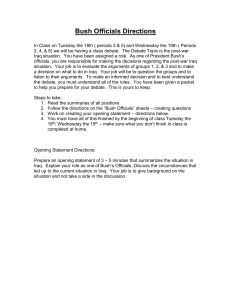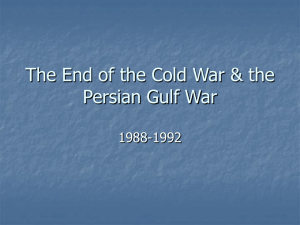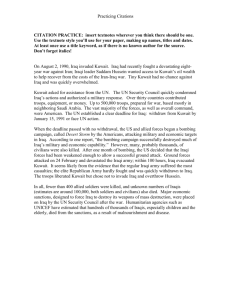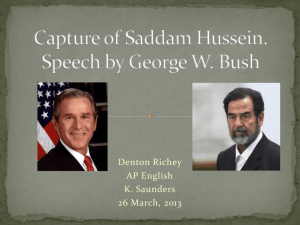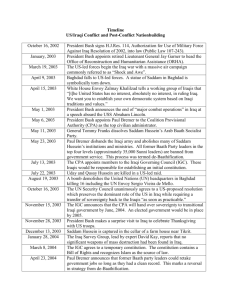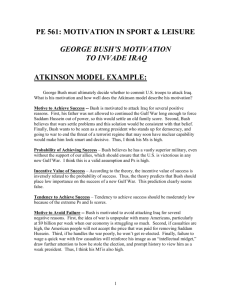George Bush and the Gulf War – A Policy Chronology
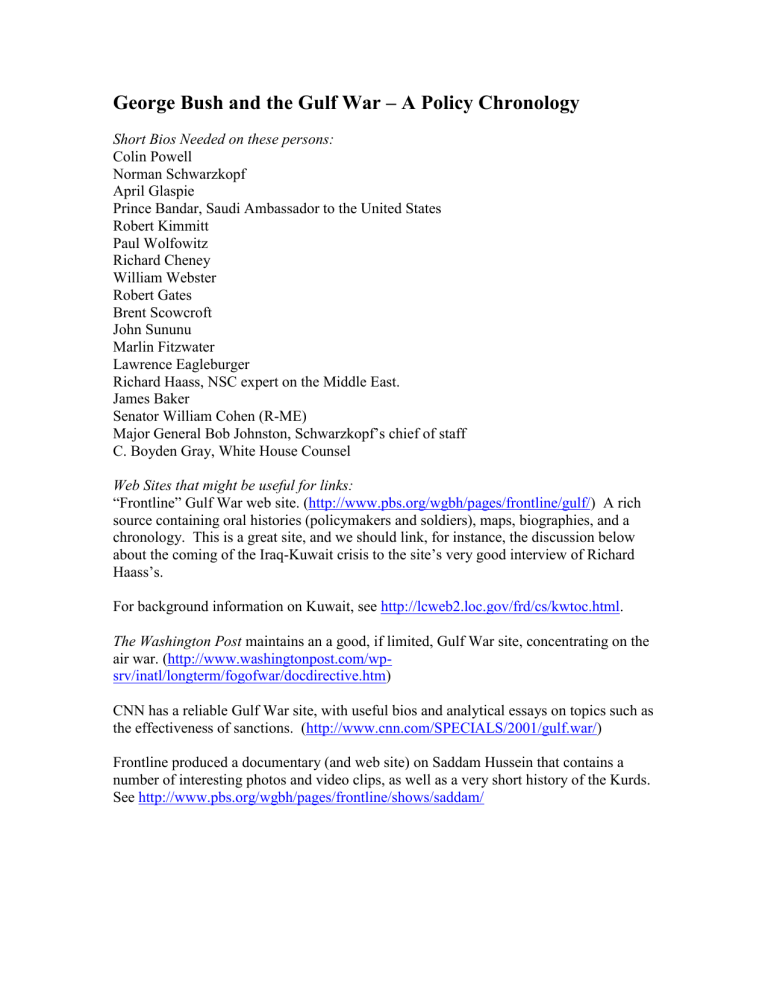
George Bush and the Gulf War – A Policy Chronology
Short Bios Needed on these persons:
Colin Powell
Norman Schwarzkopf
April Glaspie
Prince Bandar, Saudi Ambassador to the United States
Robert Kimmitt
Paul Wolfowitz
Richard Cheney
William Webster
Robert Gates
Brent Scowcroft
John Sununu
Marlin Fitzwater
Lawrence Eagleburger
Richard Haass, NSC expert on the Middle East.
James Baker
Senator William Cohen (R-ME)
Major General Bob Johnston, Schwarzkopf’s chief of staff
C. Boyden Gray, White House Counsel
Web Sites that might be useful for links:
“Frontline” Gulf War web site. ( http://www.pbs.org/wgbh/pages/frontline/gulf/ ) A rich source containing oral histories (policymakers and soldiers), maps, biographies, and a chronology. This is a great site, and we should link, for instance, the discussion below about the coming of the Iraq-Kuwait crisis to the site’s very good interview of Richard
Haass’s.
For background information on Kuwait, see http://lcweb2.loc.gov/frd/cs/kwtoc.html
.
The Washington Post maintains an a good, if limited, Gulf War site, concentrating on the air war. ( http://www.washingtonpost.com/wpsrv/inatl/longterm/fogofwar/docdirective.htm
)
CNN has a reliable Gulf War site, with useful bios and analytical essays on topics such as the effectiveness of sanctions. ( http://www.cnn.com/SPECIALS/2001/gulf.war/ )
Frontline produced a documentary (and web site) on Saddam Hussein that contains a number of interesting photos and video clips, as well as a very short history of the Kurds.
See http://www.pbs.org/wgbh/pages/frontline/shows/saddam/
1990
July 24
July 25
General Colin Powell, Chairman of the Joint Chiefs of
Staff, met with General Norman Schwarzkopf, Commander in Chief of the U.S. Central Command, to discuss the ominous situation developing on the border between Iraq and Kuwait. Beginning on July 16, American intelligence agencies received reports of the movement of Iraqi troops and equipment to the Kuwaiti border. No consensus, however, existed among intelligence analysts about Iraqi intentions and plans. Powell asked Schwarzkopf to develop a “two-tiered response” that provided for a
American retaliation in the case of either a minor border infraction, or a major incident in which the United States needed to “protect the region.” (Powell, 460; Woodward,
205-8)
The American Ambassador to Iraq, April Glaspie, met with
Iraqi President Saddam Hussein to discuss Iraqi-Kuwaiti relations. On July 17, Hussein had accused several Persian
Gulf states of “stabbing Iraq in the back” by exceeding
OPEC oil production quotas and causing the price of oil to drop. With a falling price for Iraq’s chief export, Hussein believed his country could not recover from the devastation of the Iran-Iraq war. (The next day, Iraqi Foreign Minister
Tariq Aziz identified these states: Kuwait and the United
Arab Emirates.) Several Arab leader, including Egypt’s
President Hosni Mubarek, had worked to quell the crisis diplomatically, and now Glaspie met with Hussein for the same reason. Glaspie told Hussein that the United States has “no opinion on the Arab-Arab conflicts like your border disagreement with Kuwait,” which corresponded with the Bush administration’s desire to stay out of intractable conflicts among Arab nations. The administration also wanted, however, a stable Middle East, and to this end President Bush cabled Hussein after the
Glaspie meeting that the United States “continues to desire better relations with Iraq.” (Powell, 461-462; ENPGW,
472-3) (See this interview with Richard Haass, Middle
East expert at the NSC, in which he discusses American policy towards Saddam in the year leading up to the Iraq-
Kuwait confrontation: http://www.pbs.org/wgbh/pages/frontline/gulf/oral/haass/1.
html )
August 1
July 27
August 2
Colin Powell met with Saudi Arabian Ambassador to the
United States, Prince Bandar at the Pentagon. Powell and
Bandar both believed that the Iraqis would not provoke a military crisis in the Middle East. (Woodward, 214)
At the State Department, Undersecretary of State for
Political Affairs Robert Kimmitt led a meeting to discuss the Iraq-Kuwait situation, attended by the chief deputies at the Central Intelligence Agency and the Defense
Department, as well as other departments. Most were optimistic that the dispute would resolve itself, although
Paul Wolfowitz at Defense urged a forceful American response. (Woodward, 215)
Talks between high-level Iraqi and Kuwaiti government officials ended with no resolution of the issues dividing the two nations. No further discussions were scheduled.
(EPGW, 473)
In Washington, D.C. the latest intelligence information and satellite photos showed Iraq distributing its forces along its border with Kuwait in formations that preceded offensive military operations. (Woodward, 219)
In Washington, D.C., Secretary of Defense Cheney,
Powell, and the Joint Chiefs met with General Norman
Schwarzkopf, Commander in Chief of the U.S. Central
Command, to discuss the troubling situation on the Iraq-
Kuwait border. Schwarzkopf predicted that an Iraqi invasion of Kuwait would be limited to Iraq’s seizure of the
Rumaila oil field and Bubiyan Island. Schwarzkopf also argued there was little the United States could do to repel an attack by 100,000 Iraqi troops because there were only
10,000 American troops in the region. (EPGW, 473;
Powell, 462; Woodward, 220)
Iraq invaded Kuwait, taking control of the country in a matter of hours and installing a puppet government.
President Bush condemned the Iraqi invasion during a morning appearance in the Cabinet Room of the White
House. He also signed Executive Orders 12722 and 12723 that froze both Iraqi and Kuwaiti assets in the United
States. Bush had convened a full meeting of the National
August 3
August 4
August 5
Security Council, at which Schwarzkopf outlined American military options, although no decisions were made.
At the United Nations, the Security Council voted 14 to 0, with Yemen abstaining, to condemn Iraq’s invasion of
Kuwait. They also asked for the complete and unconditional withdrawal of Iraqi forces from Kuwait.
(EPGW, 473)
President Bush met with his National Security Council, including Powell, Cheney, William Webster, Lawrence
Eagleburger, Brent Scowcroft, to discuss events in the
Persian Gulf. William Webster, director of the CIA, outlined the latest developments, as well as the consequences of a successful Iraqi invasion of Saudi
Arabia, which seemed a possibility with Iraqi forces massed at the Saudi border. Bush declared, “We’re committed to Saudi Arabia,” but made no decision about removing Iraq from Kuwait. (Powell, 464-5)
Bush and Scowcroft spoke with the Saudi Ambassador to the United States, Prince Bandar, with the goals of convincing him of the danger Hussein posed to Saudi
Arabia and that America stood willing to defend Saudi
Arabia with military force. Powell and Cheney met with
Bandar later that day to re-inforce the message. They urged him to advise King Fahd of Saudi Arabia to accept
President Bush’s offer of assistance. (Powell, 464-5)
At Camp David, President Bush met with Quayle, Cheney,
Sununu, Webster, Wolfowitz, Baker, Scowcroft, Powell,
Schwarzkopf, Marlin Fitzwater, and Richard Haass. They discussed possible American reactions to the situation in the Middle East, with Schwarzkopf presenting a detailed description of Iraq’s military capabilities and American responses. Schwarzkopf asserted that it would take 8 to 12 months to assemble a force that could forcibly remove Iraq from Kuwait. President Bush wanted the defense of Saudi
Arabia to be the focus of American policy, but he wondered whether the Saudis would accept assistance.
(Woodward, 249)
President Bush declared at the White House, “This will not stand, this aggression against Kuwait.” In the wake of the invasion, Bush and his advisers had worked almost around
August 6
August 8
August 11 the clock to ensure that world opinion strongly condemned
Iraq. (EPGW)
In Baghdad, Saddam Hussein warned American diplomat
Joseph Wilson against “any act that might endanger the region’s peace and security.” (EPGW)
Secretary of Defense Cheney, with a team that included
Schwarzkopf, Wolfowitz, and Gates, met in Riyadh, Saudi
Arabia with King Fahd, who accepted the Bush
Administration offer to deploy American troops in Saudi
Arabia as a deterrent against Iraq. That same day, the
Saudis moved a few hundred tanks to their border with Iraq to prevent an invasion. (Powell, 467; EPGW)
In Moscow, Soviet Union, Secretary of State James Baker and Soviet Foreign Minister Eduard Shevardnadze issued a statement denouncing Iraqi actions and warning of “very serious consequences” if Iraq did not comply with the
United Nations Resolution of August 2. (EPGW)
The United Nations Security Council passed Resolution
661 that provided for broad economic sanctions against
Iraq. These sanctions prohibited all UN members from importing any Iraqi or Kuwaiti products, and prevented the transfer of funds to either country. (EPGW)
Iraq announced the annexation of Kuwait. President
Hussein boasted that the threat of an American military response did not scare him. (EPGW)
President Bush announced the deployment of American troops to Saudi Arabia, titled “Operation Desert Shield.”
He also outlined four principles that guided this policy: (1) the immediate and complete withdrawal of Iraq from
Kuwait; (2) the restoration of the legitimate Kuwaiti government; (3) the stability and security of the Middle
East; (4) the protection of Americans abroad. The
Pentagon announced that by the end of the month, the
United States would have 50,000 troops in the region.
(EPGW; Woodward, 277)
British, Moroccan, and Egyptian troops arrive in Saudi
Arabia, growing evidence of a multinational coalition against Saddam Hussein and Iraq. (EPGW)
August 15
August 17
August 25
September 5
September 7
September 11
September 12
September 25
With America committed to the defense of Saudi Arabia,
Powell briefed Bush, Cheney, Scowcroft, and Sununu on the predicted pace of America’s military build-up in the
Gulf. The President, according to Powell, revealed doubts about whether sanctions would accomplish American objectives. (Powell, 470; Woodward, 281)
General Schwarzkopf received a briefing on offensive
American military options against Iraqi forces. He named the plan for these attacks “Operation Desert Storm.”
The United Nations Security Council voted to give the navies of the United States and other nations the right to blockade Iraq and stop it from conducting trade. This was a major victory for the Bush administration’s Iraq policy, as it allowed them to enforce sanctions. (EPGW, 278,
Woodward, 285)
President Bush met at the White House with 30 senators and representatives. Most praised Bush’s handling of the crisis, but Senator William Cohen (R-ME) urged Bush to exhibit caution in committing forces to military action and asked the president to get congressional approval for any operations he might undertake that put American forces at risk. (Woodward, 289)
President Bush and Soviet President Mikhail Gorbachev met in Helsinki, Finland to discuss the Persian Gulf Crisis.
They issued a joint statement that declared their willingness to take “additional steps” to end the Iraqi occupation of
Kuwait.
President Bush told a Joint Session of Congress: “We will not let this aggression stand.” He reaffirmed the four objectives of American policy he announced on August 8.
Chairman of the Joint Chiefs of Staff Colin Powell visits
American troops in the Persian Gulf region.
Powell and Cheney met with President Bush, Scowcroft, and Sununu. Powell reviewed Bush's options in the Middle
East, including a comprehensive report on how sanctions might achieve Bush's objectives. (Powell, 480; For a contrasting view that paints Powell as a dove, see
Woodward.)
October 1
October 11
October 22-23
October 30
November 3
November 8
President George Bush spoke to the United Nations
General Assembly and condemned Iraq’s invasion and annexation of Kuwait. Bush does suggest that all of Iraq’s interests in the region would be addressed if Hussein pulled out of Kuwait.
Marine Major General Bob Johnston, chief of staff for
General Schwarzkopf briefed President Bush, Vice president Quayle, Baker, Sununu, Scowcroft, Gates,
Cheney, and Powell on the military’s offensive strategy for the Gulf. It was generally agreed that the air war strategy was sound, but that the ground war plans were very weak.
(Powell, 485; Woodward, 307)
Powell met with Schwarzkopf and his staff in Saudi Arabia to map out a new offensive military strategy. After studying the positions of Iraqi forces, they decided on a plan that would trap the Iraqi army in Kuwait by cutting off its escape routes to the north and west. (The ocean was to the east, and American forces to the south.) This plan, however, would require large numbers of additional
American forces.
President Bush met at the White House with Baker,
Scowcroft, Cheney, Powell, Gates, and Sununu to discuss
American options in the Gulf, specifically whether the
United States wished to eject Iraq from Kuwait. Powell told the group that any offensive plan would require over
500,000 troops, nearly twice the number that were currently in the region. President Bush decided that the coalition forces, via the United Nations, would present an ultimatum to Iraq: depart Kuwait by a specific date or be forcibly removed. This option gave Iraq in exit option, threatened military force, but also gave sanctions additional tome to work. (Powell, 489; Woodward, 318-319)
Secretary of State Baker departed on an eight day trip to meet with American allies to discuss the military build-up in the Persian Gulf. Baker met with King Fahd on
November 4 and ironed out an agreement concerning command and control of American and Saudi forces.
President Bush announced the deployment of additional troops to the Persian Gulf, so that the coalition has “an adequate offensive military option should that be necessary to achieve our common goals.” While Bush did not state
November 10
November 15
November 29
November 30 exactly how many more American troops were being sent, he acknowledged, “We're talking about substantial numbers.” News reports estimated that as many as 240,000 additional American military personnel may be dispatched to the Gulf. In the days following the announcement, several Democrats, as well as some Republicans, expressed concern that Bush was moving the country towards war.
Secretary of State Baker returned from his meetings with
American allies and reported that a number wanted to give economic sanctions more time to work.
President Bush left on a nine day trip to Europe (to meet with American allies) and to the Middle East (to meet with
American allies and to spend Thanksgiving with American troops.)
American troops began Operation Imminent Thunder, a tactical exercise that occurred 25 miles from the Kuwaiti border. Iraq called the exercise “a provocative act.”
The U.N. Security Council voted 13-2 to approve a
Resolution 678 that authorized the use of military force to remove Iraq from Kuwait, if the Iraqis had not voluntarily withdrawn by January 15, 1991. This resolution fit the plans Bush and his advisers had established on October 30.
In addition, it testified to the strength of the international coalition aligned against Iraq. Thirty-five nations provided armaments, supplies, and manpower – over 200,000 troops
– to the effort. (Powell, 490; EPGW)
President Bush announced at a press conference that he would be willing to send Secretary of State Baker to meet with Iraqi Foreign Minister Tariq Aziz. On December 1,
Iraq accepted the offer, in principle. The two nations, however, haggled over the site of the meeting for most of
December.
President Bush met with congressional leaders in the
Cabinet Room of the White House to discuss American policy towards Iraq. Bush told those gathered that he had no second thoughts about the course he had chosen, even if it put Americans in harm’s way. Several congressmen and senators urged Bush to make a more convincing case to the
American public about U.S. objectives in the region.
(Woodward, 339)
January 2
January 4
January 6
December 19
December 24
December 27
1991
January 1
Cheney, Powell, and Wolfowitz arrived in Saudi Arabia to discuss war’s strategies and tactics with Schwarzkopf and his staff. (Woodward, 345)
Powell and Schwarzkopf discussed the ideal time to commence the coalition attack on Iraqi forces.
Schwarzkopf told Powell that once offensive maneuvers began, he would change the operations name from Desert
Shied to Desert Storm.
President Hussein announced in an interview that if the coalition attacked Iraq, Iraq would attack Israel.
President Bush met with Quayle, Baker, Cheney, Powell, and Sununu in the White House residence. Baker suggested that Bush make one last attempt to resolve the crisis diplomatically. Bush agreed and decided to propose that Baker meet with Iraqi Foreign Minister Tariq Aziz in
Geneva Switzerland during the period January 7 to January
9. Bush, however, also ordered his National Security
Council to draw up a directive that outlined the
Administration’s thinking behind going to war.
(Woodward, 353-4)
President Bush’s interview with David Frost, conducted on
December 16, aired on television. Bush outlined the case against Iraq, and told Americans, sometimes in graphic detail, of the atrocities committed by Iraq in Kuwait.
(Woodward, 343-344)
Iraqi Foreign Minister Tariq Aziz announced that he would meet with Secretary of State Baker in Geneva, Switzerland on January 9.
President Bush met at Camp David with Quayle, Baker,
Scowcroft, Powell, Cheney, Sununu, and Gates to discuss when offensive military operations would begin if Iraq failed to abide by the UN resolution ordering the evacuation of Kuwait. January 17 at 3 a.m. (Saudi Arabia time) was chosen.
President Bush also met with his staff at the White House that evening to discuss whether to ask Congress to support
January 8
January 9
January 10
January 12
January 15
January 7
January 16 the use of force to uphold the U.N. resolutions. No decision was made on how to deal with Congress.
(Woodward, 355)
President Bush and his team, including Cheney, Scowcroft,
Sununu, Eagleburger, White house Counsel C. Boyden
Gray, and others, discussed the legal and political ramifications of Bush asking Congress to authorize the use of force in the confrontation with Iraq. Scowcroft urged
Bush to ask for congressional support, while Cheney expressed reservations that Congress would deal with the issue effectively. Bush decided to send a request to
Congress; it arrived that evening. (Woodward, 357-358)
Both Baker and Aziz arrived in Geneva to prepare for their meeting.
Baker and Aziz met for over six hours in Geneva, but fail to agree on an Iraqi withdrawal from Kuwait. President
Bush said, “I can’t misrepresent this to the American people. I am discouraged.”
The U.S. Congress began debate over a resolution authorizing American forces to go to war.
Congress voted to authorize America to go to war against
Iraq. In the Senate, the resolution passed 52 to 47, and in the House of Representatives, it passed 250-183.
President Bush met in the Oval Office with Quayle, Baker,
Cheney, Scowcroft, Powell, Sununu, and Gates to sign the
National Security Directive 54, which authorized the execution of Operation Desert Storm, provided that no last minute diplomatic breakthrough occurred and that
Congress had been notified. The NSD presented the administration’s rationale for offensive military operations against Iraq. (Woodward, 366) (To read NSD 54, go to http://www.washingtonpost.com/wpsrv/inatl/longterm/fogofwar/docdirective.htm
)
Powell and Cheney send the “execute” order to
Schwarzkopf, giving him the authority to execute Desert
Storm. (Woodward, 367)
The U.N. imposed deadline for an Iraqi withdrawal from
Kuwait passed on January 15. In response, coalition forces,
January 18
January 25
January 27
January 28
January 29
January 31
February 2 led by the United States, launched a massive air attack on
Iraqi targets beginning at 3 a.m., January 17, (Saudi Arabia time.)
The coalition forces continued their air attacks, flying over
1,000 missions a day.
Iraq fired two SCUD missiles into Israel in an effort to bring Israel in to the war – and win the support of
Palestinians.
The United States accused Iraq of environmental terrorism after an oil slick appeared at the Kuwaiti port of Nina Al
Ahmadi, where Iraq destroyed several oil tankers. On
January 26, the Saudi government warned that oil released deliberately by the Iraqis from Kuwait’s Sea terminal
Island oil terminus threatens to pollute Saudi beaches.
American Air Force bombers attack Kuwait oil stations in order to stop the flow of oil into the Persian Gulf. On
January 28, the Saudi government estimated that over 11 million barrels of oil had been deliberately released into the
Persian Gulf by Iraq.
Cheney, Powell, and Wolfowitz met with a contingent of
Israeli military personnel: Rear Admiral Abraham Ben
Shoshan, defense director general David Ivri, and General
Ehud Barak, deputy chief of staff. The Israelis informed the Americans that they intended to attack directly Iraq’s
SCUD missile force. The Americans argued that the
Israelis could not do this without inflaming Arab opinion, and damaging the international coalition aligned against
Iraq. The Israelis reluctantly agreed to restrain from entering the war after the Americans agreed to hunt down and destroy the SCUD missiles. (Powell, 511)
President Bush in his State of the Union message reported on the progress of the war, and announced America’s determination to see it through.
American B-52 bombers pummeled Iraqi positions in
Southern Kuwait.
General Schwarzkopf began to finalize the planning of the ground war. Schwarzkopf rejected an amphibious landing in favor of a ground attack on Iraqi positions.
February 13
February 15
February 23
February 24
February 25
February 26
February 27
March 1
Two laser guided bombs dropped from American F-117A
Stealth fighters destroyed a hardened Iraqi bunker, killing several hundred civilians. American officials claimed that the bunker was an intelligence center shielded by civilians.
Saddam Hussein announced that he was willing to explore how Iraq could comply with U.N. Security Council
Resolution 660 – and that he was willing to withdraw his troops from Kuwait. The United States rejected the overture.
President Bush issued an ultimatum to Iraq that warned unless Iraqi troops had withdrawn from Kuwait by noon
February 23, then the ground war would commence.
The ground war commenced. Encountering light resistance, coalition troops stormed across the Saudi-Kuwaiti and the
Saudi-Iraqi borders. Thousands of Iraqi troops surrendered.
Saddam Hussein announced, less than 24 hours after the start of the ground war that Iraqi troops would withdraw immediately from Kuwait.
Coalition forces continued their rout of Iraqi forces. The
Seventh Corps of the U.S. Army fought with Hussein’s elite forces The Republican Guard at the battle of 73
Easting.
President Bush met with Quayle, Baker, Scowcroft, Gates,
Powell, Cheney, Sununu, and Richard Haass, the NSC expert on the Middle East, to discuss when to call off the coalition assault on Iraqi forces. Powell suggested waiting until February 28, but Bush, arguing that the goals of the campaign had been met, decided to announce the end of hostilities this evening.
President Bush at 9 p.m. in Washington announced that the war will end at midnight, only 100 hours after the commencement of ground operations, because Kuwait had been liberated.
President Bush told reporters, in assessing the Americanled coalition victory over Iraq, “By God, we’ve licked the
Vietnam syndrome once and for all.”
March 6
March 7
March 8
March 9
March 12
March 15
March 22
March 23
March 25
March 26
Reports circulated in the United States of a rebellion in the
Iraqi city of Basra, led by Shi’ite Muslims opposed to
Saddam Hussein. (EPGW)
President Bush addressed a joint session of Congress and announced, “The war is over.” (EPGW)
Kurds, an ethnic minority in Iraq, began an uprising against
Saddam Hussein. (EPGW)
Hussein deployed forces around Baghdad and expelled journalists from the city as he prepared to defend his regime from its domestic opponents. (EPGW)
President Bush warned Hussein not to use chemical weapons against the Shi’ite rebels. (EPGW)
Iraqi opposition leaders announced that Hussein’s troops attacked Shi’ite rebels in the cities of Karbala and Najaf in south-central Iraq. (EPGW)
Kurdish rebels announced that they controlled most of northern Iraq. (EPGW)
Mazoud Barzani, leader of the Kurdish rebellion, called for a meeting of all opposition leaders to discuss the formation of a provisional Iraqi government. Fighting between
Shi’ites and Hussein’s troops, especially the Republican
Guard, grew in Southern Iraq. Fighting between Kurdish rebels and Hussein’s forces also grew in northern Iraq.
(EPGW)
With the rebellion against his regime growing, Hussein attempted to quell discontent by shuffling his government.
He appointed a Shi’ite Muslim Prime Minister in the hope of winning the approval of Shi’ites in southern Iraq.
(EPGW)
The American media reported that Iraqi Republican Guard units launched brutal attacks against Shi’ite rebels in southern Iraq. (EPGW)
American officials, the New York Times reported, believed that the Shi’ite rebellion in southern Iraq was almost over, crushed by Iraqi military forces loyal to Hussein. They
March 27
March 28
March 30-31
April 1
April 2
April 4
April 5 also believed the Kurdish revolt in northern Iraq would suffer the same fate. (EPGW)
General Norman Schwarzkopf, in an interview with David
Frost, claimed that he wanted to continue the ground war in
February until the elite Republican Guard had been destroyed, but that President Bush overruled him. The
Bush Administration vigorously disputed Schwarzkopf’s account. (EPGW)
Iraqi forces made major strides in quelling the Kurdish rebellion in northern Iraq. (EPGW)
The Kurdish rebellion in northern Iraq collapsed, leading to major refugee flows into the mountains of Northern Iraq and Turkey. (EPGW)
The Turkish government appealed to the world community, including the United States, to help the Kurdish refugees fleeing Iraq. (EPGW)
The Department of Defense announced that Iraqi troops loyal to Hussein had regained control of most of northern
Iraq from Kurdish rebels. (EPGW)
Turkey and France requested that the UN Security Council address the Kurdish refugee problem. The Security
Council refused. (EPGW)
President Bush received criticism for the lack of American assistance to the Kurdish insurgency. Bush responded: “It was never a stated objective of the coalition to intervene in the internal affairs of Iraq…But I do not want to see United
States forces, who have performed with such skill and dedication, sucked into a civil war in Iraq.” (EPGW)
(Bush's statement can be found at: http://bushlibrary.tamu.edu
)
President Bush announced the beginning of a massive aid and relief operation in northern Iraq, in which the United
States Air Force would drop food and humanitarian aid to
Iraqi refugees. It was titled "Operation Provide Comfort."
(For Bush's statements on refugee relief, as well as a number of press conferences in which he addressed these topics, see http://bushlibrary.tamu.edu
)
April 10
April 16
May 13
May 18
June 13
June 29
1992
May 19
August 26
1993
The United Nations Security Council passed Resolution
688, which called on Iraq not to repress its Kurdish and
Shi’ite minorities. (Read the resolution (in a PDF file) at: http://www.un.org/Docs/scres/1991/688e.pdf
)
The United States warned Hussein not to disrupt Operation
Provide Comfort, ordering him not to conduct any military operations in northern Iraq. This was the beginning of the northern “no fly zone” as the United States and its allies patrolled the skies north of the 36 th
parallel to prevent
Hussein from using his still dangerous air forces against the
Kurds.
Coalition forces established a “safe zone” for Kurdish refugees. The United States opened relief camps for over
850,000 refugees.
The United States turned over control of the Kurdish refugee camps to the United Nations.
Kurdish leader Masoud Barsani announced that he had reached an agreement with Iraq that would permit an autonomous Kurdish region in northern Iraq, although many details still remained unresolved.
The last American troops involved in the ground war part of Desert Storm returned to the United States.
Kurdish opposition leaders rejected an autonomy agreement offered by the Iraqi government.
Kurds in northeastern Iraq held elections for an autonomous Kurdish legislature. The elections end in a draw and the Democratic party of Kurdistan and the
Patriotic Union of Kurdistan agreed to share power.
President Bush announced that Iraqi aircraft flying over southern Iraq to attack Shi’ites would be shot down. This is the beginning of Operation Southern Watch, which enforced a “no-fly” zone over southern Iraq which continues to this day.
January 13 The United States, along with Britain and France, launch air attacks on Iraqi military installations. The attacks were launched because Iraq had violated U.N. resolutions, had embarked on several military incursions into Kuwait, had threatened to shoot down coalition aircraft patrolling the southern and northern “no fly zones,” and had failed to withdraw anti-air craft defenses from northern Iraq. The coalition struck again on January 17, 18, 19, and 21, further dismantling Iraqi defenses. (EPGW)
